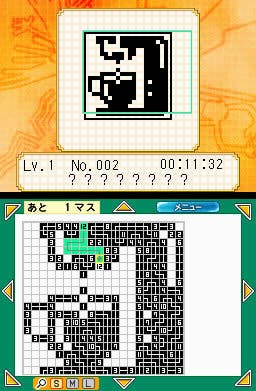Pic Pic
This year's Slitherlink!
Let me tell you a romantic story. There was once a man who loved puzzle games. He bought a DS, and then played puzzle games on it for about 90 per cent of his waking life. The end.
While short, I think it's safe to say that's one of the most beautiful and moving tales of love and happiness that the world has ever known. The DS, for all its tinny sound and horribly region-locked future, is the greatest thing for puzzling chaps and chapesses since the invention of the pencil. Pick it up, run into the street, hold it above your head, and shout, "I love my DS and your laws and your twisted moralities can never keep us apart!"
Good. Now welcome to Pic Pic. You may already be very familiar with this, as it's already a year old. But like Slitherlink before it, this isn't about being fresh out the factory - it's about being a truly great puzzle game that you likely haven't heard about.
Pic Pic is, of course, originally a Japanese puzzle game (as no other country appears capable of creating a good one), but unusually has been translated and relocated for English-speaking types. (Something we still dearly wish would happen for Slitherlink). Originally called the slightly less catchy PikuPiku: Toku to E Ninaru 3-tsu no Puzzle, it's three puzzle games on one cart. And they're all great.

One stands out - Drawing. But before we get to that, bear with me for the onerous task of describing a visual puzzle in words - it's never a simple matter.
All three are built around a shared theme: completing a puzzle to reveal a picture on the top screen. Maze Paint is the simplest of the three - it's solving mazes. Something you've likely not done since you were a kid. The difference here is the path taken to find the solution paints blocky lines on the corresponding top screen, which results in a cute image. These start off pretty simply, but quickly become astonishingly enormous. There's a remarkable 400 maze puzzles here, and skipping ahead to look at number 354, say, is terrifying. The bottom screen, on the most zoomed out setting, still only shows about a twelfth of the total pattern shown in full above. It's the stuff of crazed fluey nightmares, trapped in a labyrinth larger than your mind can comprehend. HELP! And yet, ooh, what a nice picture.
I'm saving Drawing for last, so next is Magipic. Here you have a grey grid, with numbers in about half the squares. The idea is to paint the corresponding number of tiles black to which each number is adjacent. Um, bear with me. So, if there's a 9 on the grid, then the square itself and all those immediately surrounding go black. A 6 touching the edge of the screen is going to receive the same. A 6 in the middle of the screen is obviously not immediately solvable. A 0, meanwhile, is filled in with surrounding whites. So you start by filling in all the 9s and 0s, and then the rest becomes more obvious. A 6 alongside the surrounding whites of 0 can now have its remaining squares filled in black, etc.

